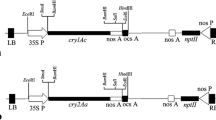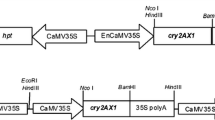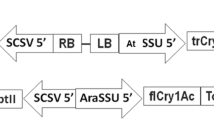Abstract
The Bacillus thuringiensis cry9Aa2 gene encodes a 129 kDa protein with insecticidal activity against Lepidoptera, including the larvae of potato tuber moth (Phthorimaea operculella). The insecticidal moiety of Cry9Aa2 resides within the N-terminal 665 amino acids. Site-directed mutagenesis was used to modify a truncated version of the gene (cry9Aa2T nucleotides 1–1995), removing motifs likely to be deleterious to full-length transcription and transcript stability in plants. The codon usage of the gene was also altered to that more similar to the codon bias of dicotyledonous plant genes. The native gene and three modified versions of cry9Aa2T, with incremental modifications from the 5' end, were each transformed into Nicotiana tabacum, under the control of the CaMV 35S promoter. Plants transformed with the native gene did not show resistance to potato tuber moth larvae. In contrast, significant levels of larval mortality and reductions in larval growth and leaf damage were observed on many of the plants transformed with the modified genes. The cry9Aa2T mRNA was barely detectable in plants transformed with the native gene, whereas significant accumulation of full-length cry9Aa2T transcript was seen in plants transformed with modified genes. Modifications in the 5'-terminal 693 nucleotides of cry9Aa2T had the most significant effect on increasing the steady-state levels of cry mRNA. Transcription initiation rates of both the native and modified cry9Aa2T genes were similar, suggesting that the lack of native transcript accumulation was a consequence of transcript instability and that the sequence modifications had significantly improved the stability of the cry9Aa2T transcript. This improvement in steady-state full-length transcript levels resulted in expression of the insecticidal gene in N. tabacum to levels which conferred significant resistance to potato tuber moth larvae. Abbreviations: CaMV, cauliflower mosaic virus; IPTG, isoprophylthio-β-galactoside; PCR, polymerase chain reaction; poly(A), polyadenylation; PTM, potato tuber moth; UTR, untranslated region.
Similar content being viewed by others
References
Adang MJ, Brody MS, Cardineau G, Eagen N, Roush R, Shewmaker CK, Jones A, Oakes JV, McBride K: The reconstruction and expression of a Bacillus thuringiensis cryIIIA gene in protoplasts and potato plants. Plant Mol Biol 21: 1131–1145 (1993).
Atkinson RG, Eagles RM, Forster RL, Gardner RC: Genetic transformation of Cyphomandra betacea (Tamarillo). In: Bajaj YPS (ed) Biotechnology in Agriculture and Forestry, vol. 29. Plant Protoplasts and Genetic Engineering V, pp. 271–284. Springer-Verlag, Berlin/Heidelberg/New York (1994).
Ausubel FM, Brent R, Kingston RE, Moore DD, Seidman JG, Smith JA, Struhl K: Current protocols in molecular biology. Greene Publishing Associates/John Wiley, New York (1987).
Barton KA, Whiteley HR, Yang N-S: Bacillus thuringiensis δ-endotoxin expressed in transgenic Nicotiana tabacum provides resistance to lepidopteran insects. Plant Physiol 85: 103–1109 (1987).
Brown JWS: A catalogue of splice junction and putative branch point sequences from plant introns. Nucl Acids Res 14: 9549–9559 (1986).
Crickmore N, Zeigler DR, Feitelson J, Schnepf E, Lereclus D, Baum J, Van Rie J, Dean DH: Bacillus thuringiensis δ-endotoxin nomenclature. http://epunix.biols.susx.ac.uk/Home/Neil?Crickmore/Bt/index. html (1997).
Cox KH, Goldberg RB: Analysis of plant gene expression. In: Shaw CH (ed) Plant Molecular Biology: A Practical Approach, pp. 1–35. IRL Press, Oxford (1988).
Diehn SH, De Rocher EJ, Green PJ: Problems that can limit the expression of foreign genes in plants: lessons to be learned from B.t. toxin genes. In: Setlow JK (ed) Genetic Engineering, vol 18, pp. 83–99. Plenum Press, New York (1996).
Doyle JL, Doyle JL: Isolation of plant DNA from fresh tissue. Focus (Gibco-BRL) 12: 13–15 (1990).
Ferre J, Real MD, Van Rie J, Jansens S, Peferoen M: Resistance to the Bacillus thuringiensis bioinsecticide in a field population of Plutella xylostella is due to a change in a midgut membrane receptor. Proc Natl Acad Sci USA 88: 5119–5123 (1991).
Fischhoff DA, Bowdish KS, Perlak FJ, Marrone PG, Mc-Cormick SM, Niedermeyer JG, Dean DA, Kusano-Kretzmer K, Mayer EJ, Rochester DE, Rogers SG, Fraley RT: Insect tolerant transgenic tomato plants. Bio/technology 5: 807–813 (1987).
Gleave AP, Williams R, Hedges RJ: Screening by polymerase chain reaction of Bacillus thuringiensis serotypes for the presence of cryV-like insecticidal protein genes and characterisation of a cryV gene cloned from B. thuringiensis subsp. kurstaki. Appl Environ Microbiol 59: 1683–1687 (1993).
Gleave AP, Hedges RJ, Broadwell AH: Identification of an insecticidal crystal protein from Bacillus thuringiensis DSIR517 with significant sequence differences from previously described toxins. J Gen Microbiol 138: 55–62 (1992).
Gleave AP: A versatile binary vector system with a T-DNA organisational structure conducive to efficient integration of cloned DNA into the plant genome. Plant Mol Biol 20: 1203–1207 (1992).
Harris MO, Mafile'o F, Dhana S: Behavioural responses of lightbrown apple moth neonate larvae on diets containing Bacillus thuringiensis formulations or endotoxins. Entomol Exp Appl 84: 207–219 (1997).
Hoffman NE, Kenton K, Milkowski D, Pichersky E: Isolation and characterisation of tomato cDNA and genomic clones encoding the ubiquitin gene ubi3. Plant Mol Biol 17: 1189–1201 (1991).
Hofte H, Whiteley HR: Insecticidal crystal proteins of Bacillus thuringiensis. Microbiol Rev 53: 242–255 (1989).
Horsch RB, Fry JE, Hoffman NL, Eichholz D, Rogers SG, Fraley RT: A simple and general method for transferring genes into plants. Science 227: 1229–1231 (1985).
Jansens S, van Vliet A, Dickburt C, Buysse L, Piens C, Saey B, De Wulf A, Gossele V, Paez A, Gobel E, Peferoen M: Transgenic corn expressing a Cry9C insecticidal protein from Bacillus thuringiensis protected from European Corn Borer damage. Crop Sci 37: 1616–1624 (1997).
Joshi CP: Putative polyadenylation signals in nuclear genes of higher plants: a compilation and analysis. Nucl Acids Res 15: 9627–9640 (1987).
Li J, Carroll J, Ellar D: Crystal structure of insecticidal δ-endotoxin from Bacillus thuringiensis at 2.5 Å resolution. Nature 353: 815–821 (1991).
McGaughey WH, Whalon ME: Managing insect resistance to Bacillus thuringiensis toxins. Science 258: 1451–1455 (1992).
Meisner J, Ascher KRS, Lowie D: Phagostimulants for the larvae of the potato tuber moth, Gnorimoschema operculella Zell. Z Angew Entomol 77: 77–106 (1974).
Murray EE, Rocheleau T, Eberle M, Stock C, Sekar V, Adang M: Analysis of unstable RNA transcripts of insecticidal crystal protein genes of Bacillus thuringiensis in transgenic plants and electroporated protoplasts. Plant Mol Biol 16: 1035–1050 (1991).
Murray EE, Lotzer J, Eberle M: Codon usage in plant genes. Nucl Acids Res 17: 477–498 (1989).
Ohme-Takagi M, Taylor CB, Newman TC, Green PJ: The effect of sequences with high AU content on mRNA stability in tobacco. Proc Natl. Acad Sci USA 90: 11811–11815 (1993).
Peach C, Velten J: Transgene expression variability (position effect) of CAT and GUS reporter genes driven by linked divergent T-DNA promoters. Plant Mol Biol 17: 49–60 (1991).
Perlak FJ, Stone TB, Muskopf YM, Petersen LJ, Parker GB, McPherson SA, Wyman J, Love S, Reed G, Biever D, Fischhoff DA: Genetically improved potatoes: protection from damage by Colorado potato beetles. Plant Mol Biol 22: 313–321 (1993).
Perlak FJ, Fuchs RL, Dean DA, McPherson SA, Fischhoff DA: Modification of the coding sequence enhances plant expression of insect control protein genes. Proc Natl Acad Sci USA 88: 3324–3328 (1991).
Perlak FJ, Deaton RW, Armstrong TA, Fuchs RL, Sims SR, Greenplate JT, Fischhoff DA: Insect resistant cotton plants. Bio/technology 8: 939–943 (1990).
Ramachandran R, Raffa KF, Miller MJ, Ellis DD, McCown BH: Behavioural responses and sublethal effects of Spruce budworm (Lepidoptera: Tortricidae) and Fall webworm (Lepidoptera: Arctiidae) larvae to Bacillus thuringiensis CryIA(a) toxin in diet. Environ Entomol 22: 197–211 (1993).
Strizhov N, Keller M, Mathur J, Koncz-Kalman Z, Bosch D, Prudovsky E, Schell J, Sneh B, Koncz C, Zilberstein A: A synthetic cryIC gene, encoding a Bacillus thuringiensis δ-endotoxin confers Spodoptera resistance in alfalfa and tobacco. Proc Natl Acad Sci USA 93: 15012–15017 (1996).
Sullivan ML, Green PJ: Post-transcriptional regulation of nuclear-encoded genes in high plants: the roles of mRNA stability and translation. Plant Mol Biol 23: 1091–1104 (1993).
Sutton DW, Havstad PK, Kemp JD: Synthetic cryIIIA gene from Bacillus thuringiensis improved for high expression in plants. Transgen Res 1: 228–236 (1992).
Vaeck M, Reynaerts A, Hofte H, Jansens S, De Beuckeleer M, Dean C, Zabeau M, Van Montegu M, Leemans J: Transgenic plants protected from insect attack. Nature 328: 33–37 (1987).
Van Aarssen R, Soetaert P, Stam M, Dockx J, Gossele V, Suerink J, Reynaerts A, Cornelissen M: cry IA(b) transcript formation in tobacco is inefficient. Plant Mol Biol 28: 513–524 (1995).
Van Hoof A, Green PJ: Rare codons are not sufficient to destabilise a reporter gene transcript in tobacco. Plant Mol Biol 35: 383–387 (1997).
Van Rie J, McGaughey WH, Johnson DE, Barnett BD, Van Mellaert H: Mechanism of insect resistance to the microbial insecticide Bacillus thuringiensis. Science 247: 72–74 (1990).
Vankan P, Filipowicz W: Structure of U2 snRNA genes of Arabidopsis thaliana and their expression in electroporated plant protoplasts. EMBO J 7: 791–799 (1988).
Walters FS, Slatin SL, Kulesza CA, English LH: Ion channel activity of N-terminal fragments from CryIA(c)δ-endotoxin. Biochem Biophys Res Commun 196: 921–926 (1993).
Wu L, Ueda T, Messing J: The formation of mRNA 3′-ends in plants. Plant J 8: 323–329 (1995).
Wunn J, Kloti A, Burkhardt PK, Ghosh Biswas GC, Launis K, Iglesias VA, Potrykus I: Transgenic indica rice breeding line IR58 expressing a synthetic cryIA(b) gene from Bacillus thuringiensis provides effective insect pest control. Bio/technology 14: 171–176 (1996).
Author information
Authors and Affiliations
Corresponding author
Rights and permissions
About this article
Cite this article
Gleave, A.P., Mitra, D.S., Markwick, N.P. et al. Enhanced expression of the shape Bacillus thuringiensis cry9Aa2 gene in transgenic plants by nucleotide sequence modification confers resistance to potato tuber moth. Molecular Breeding 4, 459–472 (1998). https://doi.org/10.1023/A:1009654400040
Issue Date:
DOI: https://doi.org/10.1023/A:1009654400040




